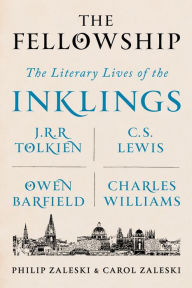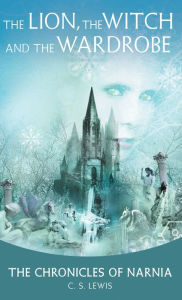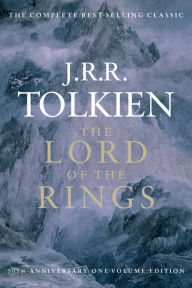4 Ways The Fellowship Shows Us Middle Earth and Narnia Are Two Sides of the Same Coin
For a reader only casually aware of “fantasy” works, The Chronicles of Narnia and The Lord of the Rings might be lumped together as “Fantasy.” For those who are familiar with the books, however, they’re often placed on opposite sides of the fantasy spectrum, with Lewis’s books regarded as lightweight, overtly allegorical children’s books, and Tolkien’s epic viewed as ponderous and weighty, what with its constructed languages and deep field mythology.
The Fellowship: The Literary Lives of the Inklings: J.R.R. Tolkien, C. S. Lewis, Owen Barfield, Charles Williams
The Fellowship: The Literary Lives of the Inklings: J.R.R. Tolkien, C. S. Lewis, Owen Barfield, Charles Williams
By Philip Zaleski , Carol Zaleski
Hardcover
$24.03
$35.00
But if you read excellent new book The Fellowship, which explores the relationships between Tolkien, Lewis, and other writers as part of their informal group The Inklings, which met near the University of Oxford from the early 1930s until the late 1940s, you’ll understand Tolkien and Lewis had an immense influence on each other—and thus on each other’s creations. Once you understand the relationship between these two writers, it’s easy to see Narnia and Middle Earth are fundamentally linked. Here are five ways The Fellowship shows us Narnia and Middle Earth are cut from the same cloth.
Both are Christian works
The latent Christian themes and symbolism in the Narnia books has been discussed many times. Lewis came to his faith with difficulty; raised Protestant in Belfast, he was a troubled atheist when he met the Catholic Tolkien in the mid-1920s. Tolkien himself was instrumental in bringing Lewis back to Christianity, and he also influenced Lewis’ conception of allegory and symbolism. Like the Narnia books, The Lord of the Rings can be viewed as essentially Christian in its philosophy: from the long-awaited return of the King (the second coming) to Saruman’s fall that is essentially Lucifer’s failed rebellion, to Aslan as a Christ figure, both men imbued their most famous works with distinct—if obscured—Christian themes and symbols.
But if you read excellent new book The Fellowship, which explores the relationships between Tolkien, Lewis, and other writers as part of their informal group The Inklings, which met near the University of Oxford from the early 1930s until the late 1940s, you’ll understand Tolkien and Lewis had an immense influence on each other—and thus on each other’s creations. Once you understand the relationship between these two writers, it’s easy to see Narnia and Middle Earth are fundamentally linked. Here are five ways The Fellowship shows us Narnia and Middle Earth are cut from the same cloth.
Both are Christian works
The latent Christian themes and symbolism in the Narnia books has been discussed many times. Lewis came to his faith with difficulty; raised Protestant in Belfast, he was a troubled atheist when he met the Catholic Tolkien in the mid-1920s. Tolkien himself was instrumental in bringing Lewis back to Christianity, and he also influenced Lewis’ conception of allegory and symbolism. Like the Narnia books, The Lord of the Rings can be viewed as essentially Christian in its philosophy: from the long-awaited return of the King (the second coming) to Saruman’s fall that is essentially Lucifer’s failed rebellion, to Aslan as a Christ figure, both men imbued their most famous works with distinct—if obscured—Christian themes and symbols.
The Lion, the Witch and the Wardrobe (Chronicles of Narnia Series #2)
The Lion, the Witch and the Wardrobe (Chronicles of Narnia Series #2)
By
C. S. Lewis
Illustrator
Pauline Baynes
In Stock Online
Paperback
$6.99
$7.99
Both draw on existing mythologies
Lewis and Tolkien developed a deep friendship over the years, bonding over a shared love of old myths and a refutation of modernity—both preferred to read ancient works and both disdained many of the trappings of the modern world. Both the Chronicles of Narnia and The Lord of the Rings take many of their elements from the ancient myths our culture is based on—often the same myths, leaving us with two magic horns that summon help, two sets of living trees that march as an army to defeat evil, and even two similar creation stories, as both worlds are sung into existence from a void.
Both underscore the fragility of evil
In both works, descriptions of evil are only superficially impressive and frightening. Sauron and the Ringwraiths, the White Witch or the god Tash are all initially creatures to be feared, but are eventually shown to be little more than our own frailties and weaknesses. Sauron’s power depends entirely on man’s vanity and quest for importance. Lewis’ ultimate evil—the evil that brings about the end of the world—is a talking ape dressed in a lion skin. Lewis and Tolkien were each other’s primary audience before they found publication, bouncing first drafts and ideas off of each other (and the other members of the Inklings), and their shared view of human nature is clear.
Both draw on existing mythologies
Lewis and Tolkien developed a deep friendship over the years, bonding over a shared love of old myths and a refutation of modernity—both preferred to read ancient works and both disdained many of the trappings of the modern world. Both the Chronicles of Narnia and The Lord of the Rings take many of their elements from the ancient myths our culture is based on—often the same myths, leaving us with two magic horns that summon help, two sets of living trees that march as an army to defeat evil, and even two similar creation stories, as both worlds are sung into existence from a void.
Both underscore the fragility of evil
In both works, descriptions of evil are only superficially impressive and frightening. Sauron and the Ringwraiths, the White Witch or the god Tash are all initially creatures to be feared, but are eventually shown to be little more than our own frailties and weaknesses. Sauron’s power depends entirely on man’s vanity and quest for importance. Lewis’ ultimate evil—the evil that brings about the end of the world—is a talking ape dressed in a lion skin. Lewis and Tolkien were each other’s primary audience before they found publication, bouncing first drafts and ideas off of each other (and the other members of the Inklings), and their shared view of human nature is clear.
The Lord of the Rings
The Lord of the Rings
In Stock Online
Paperback $20.00
The heroes are the small and the weak
The Inklings was as much a social group of friends as it was a writing group, and they knew each other intimately—and did not always agree. Arguments and bitter disagreements weren’t uncommon, but both Tolkien and Lewis shared a fundamental belief that even the small and “unimportant” could have a positive and possibly transformative effect on the world. In both stories, it’s the weakest who triumph over the powerful: in Narnia, mice and children save the day. In Middle Earth, Hobbits make for the most unlikely heroes.
The Inklings was one of the most erudite and talented groups of friends to ever gather in a local pub to drink, smoke, and discuss writing, religion, and everything else. We would not have the stories of Middle Earth or Narnia without this group—at least not in their final versions—and The Fellowship offers a deeply researched and detailed account of this most extraordinary gathering. When viewed through the lens of the most famous works produced by its members, we can glimpse the brilliance that gathered in Oxford nearly 80 years ago.
Shop more biography >
The heroes are the small and the weak
The Inklings was as much a social group of friends as it was a writing group, and they knew each other intimately—and did not always agree. Arguments and bitter disagreements weren’t uncommon, but both Tolkien and Lewis shared a fundamental belief that even the small and “unimportant” could have a positive and possibly transformative effect on the world. In both stories, it’s the weakest who triumph over the powerful: in Narnia, mice and children save the day. In Middle Earth, Hobbits make for the most unlikely heroes.
The Inklings was one of the most erudite and talented groups of friends to ever gather in a local pub to drink, smoke, and discuss writing, religion, and everything else. We would not have the stories of Middle Earth or Narnia without this group—at least not in their final versions—and The Fellowship offers a deeply researched and detailed account of this most extraordinary gathering. When viewed through the lens of the most famous works produced by its members, we can glimpse the brilliance that gathered in Oxford nearly 80 years ago.
Shop more biography >


